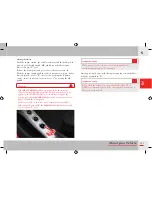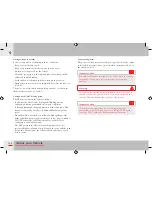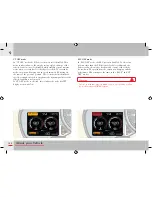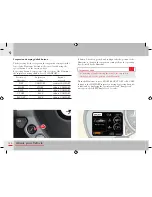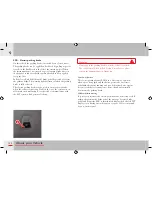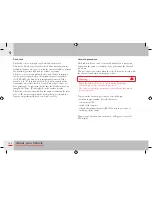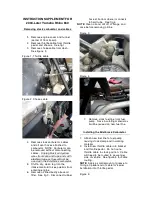
141
About your Vehicle
3
Safe driving
For safe driving, it is essential that the driver be aware of the best
driving techniques suited to various circumstances. Always try to
prevent dangerous situations by driving with caution.
Before you drive
- Adjust the position of the seat, steering wheel and rear-view
mirrors, in order to obtain the best driving position.
- Adjust the backrest so that your chest is upright and your head is
as close to the headrest as possible.
- Ensure that nothing (e.g. mat covers, etc.) is blocking the pedals.
- Check that the lights and headlights are working properly.
- Ensure that any child restraint systems (e.g. child seats, cradles
etc.) are properly fixed on the passenger seat.
- Your reflexes are quicker if you eat lightly before driving: avoid
heavy meals before a trip.
- Do not drink alcoholic drinks before and during the journey.
At regular intervals, check the following:
- Tyre pressure and condition.
- Engine oil level.
- Engine coolant level and system condition.
- Brake fluid level.
- Steering fluid level.
- Windscreen washer fluid level.
While travelling
- Caution is the number one rule for safe driving, which also means
you should take other people’s behaviour into consideration.
- Follow the Road Regulations in force in the country you are
driving in and always respect the speed limit.
- Always make sure that the driver and passengers have their seat
belts fastened and that all children are travelling in suitable child
seats.
- Good personal physical conditions ensure you can drive long
distances safely.
Warning
Driving under the influence of drugs, some medicines
and alcohol is dangerous to yourself and others as well as
contravening road regulations and legal norms.
Travelling without your seat belt fastened increases the risk
of serious injury and death in the event of a collision. Always
fasten seat belts and use child seats, if present.
Do not travel with objects lying on the floor, especially in front
of the driver’s seat: in the event of braking, these could slide
under the pedals, making it impossible to brake or accelerate.
Additionally, ensure that any loose floor mats sit correctly.
Water, ice and salt spread on icy roads may deposit on the brake
discs and reduce the efficiency of the initial braking.
Содержание 488
Страница 1: ......
Страница 3: ......
Страница 13: ...GENERAL 1 ...
Страница 16: ...16 General ...
Страница 17: ...17 General 1 ...
Страница 24: ...24 General Identification and homologation plates and labels A B E F G L M O P N H C Q R ...
Страница 26: ...26 General A Low beam homologation B ECE homologation C Vehicle identification ...
Страница 27: ...27 General 1 E Passenger airbag warning F Unleaded fuel G Radiator with antifreeze H Engine type and number ...
Страница 28: ...28 General L Assembly number M Engine and gearbox oil label N Gearbox type and number O Tyre pressure and type ...
Страница 29: ...29 General 1 P TPMS present warning Q Chassis number R Original paintwork ...
Страница 41: ...SAFETY 2 ...
Страница 71: ...ABOUT YOUR VEHICLE 3 ...
Страница 82: ...82 About your Vehicle Instruments and gauges 6 5 1 5 3 7 2 5 4 5 ...
Страница 199: ...199 About your Vehicle 3 ...
Страница 201: ...ADVICE FOR EMERGENCY SITUATIONS 4 ...
Страница 237: ...CARE OF THE VEHICLE 5 ...
Страница 254: ...Glossary 257 ...
Страница 255: ...GLOSSARY 6 ...
Страница 256: ......
Страница 260: ...Table of Contents 262 ...
Страница 261: ...TABLE OF CONTENTS 7 ...











